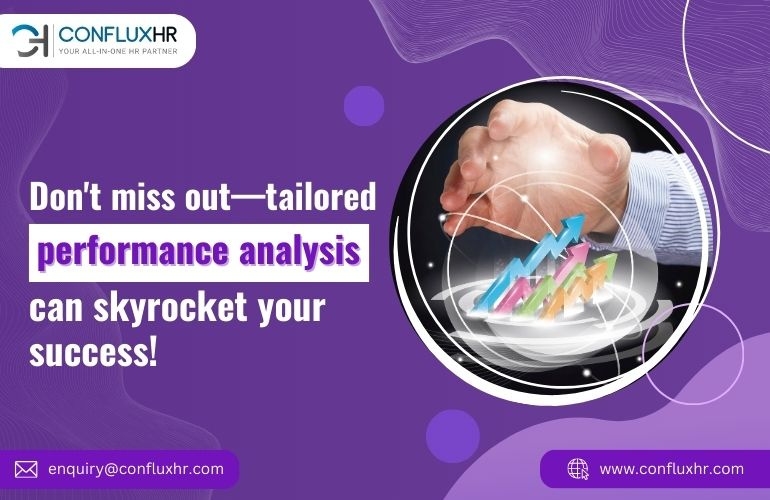In 2025, success won’t just be measured by KPIs but by how personalized your tools are. As businesses evolve in response to global workplace trends, the ability to customize performance analysis tools is no longer a luxury—it’s a necessity. Welcome to a new era where organizations prioritize employee growth and operational efficiency by leveraging innovative technologies that seamlessly blend with human capital management (HCM) systems and corporate payroll services.
The Changing Face of Employee Performance Appraisal
For decades, businesses relied on one-size-fits-all appraisal systems to gauge employee performance. While effective in their time, these systems lacked the flexibility to address the unique demands of modern workplaces. With the rise of hybrid work models and the increasing diversity of roles, traditional methods struggle to keep pace.
Customizable performance analysis tools bridge this gap. Unlike their predecessors, these tools adapt to diverse job roles, offering tailored metrics and actionable insights. Consider a hybrid workforce where a remote developer, an in-office HR manager, and a sales executive all contribute differently to organizational goals. Customizable tools enable businesses to set distinct benchmarks for each role, ensuring fair and accurate evaluations.
Why Customization is the Key to Success
Customization empowers businesses to unlock the full potential of their workforce. Here’s how:
1. Adaptability to Different Roles and Industries
Not all roles are created equal. Customizable tools cater to specific job requirements, allowing organizations to set unique performance parameters for each team member. This ensures that individual contributions align with organizational goals.
2. Employee Engagement and Motivation
When employees feel that their performance is measured against personalized goals, they are more likely to remain engaged. Custom tools help boost morale by fostering a sense of ownership and accountability.
3. Better Decision-Making
Tailored data insights offer managers a clearer picture of team dynamics. For example, identifying top performers for promotions or understanding areas where employees need additional training becomes straightforward with personalized analytics.
4. Scalability
As companies grow, customizable tools scale effortlessly, accommodating larger teams or new departments without disrupting workflows.
Benefits of Customizable Performance Analysis Tools
The advantages of these tools extend to both employees and employers:
For Employees:
- Clearer Performance Expectations: Employees understand exactly what is expected of them.
- Real-Time Feedback: Continuous feedback mechanisms allow employees to make improvements in real time.
- Growth Opportunities: Tools with self-assessment features enable employees to identify areas for personal development.
For Employers:
- Increased Productivity: Clear goals and timely feedback enhance overall team performance.
- Improved Retention Rates: Engaged employees are less likely to leave.
- Strategic Alignment: Performance metrics aligned with strategic goals drive organizational success.
Integration with Corporate Payroll Services and HCM
Seamless integration with corporate payroll services and HCM platforms adds a layer of automation that enhances efficiency. Performance-based bonuses, rewards, and promotions can be automatically processed, saving time and reducing errors. For instance, linking performance data with payroll systems allows organizations to reward top performers instantly, fostering a culture of recognition.
Features of a Robust Customizable Performance Analysis Tool
To truly transform performance management, these tools must offer certain key features:
- Dynamic Goal Setting
Employees’ goals often shift with changing priorities. A robust tool ensures that targets remain relevant and achievable. - Real-Time Reporting and Analytics
Managers and employees receive instant updates on progress, enabling timely interventions. - Integrations with Key Systems
The ability to integrate with CRM platforms, project management software, and payroll systems ensures smooth operations. - 360-Degree Feedback Mechanisms
Tools that incorporate peer evaluations and self-assessments provide a well-rounded view of performance. - AI-Driven Recommendations
Leveraging artificial intelligence (AI) to suggest personalized growth plans helps employees and organizations stay ahead of the curve.
Industry Trends Driving the Need for Customizable Tools in 2025
The demand for customizable performance analysis tools stems from several key industry trends:
- The Rise of AI in HR Tech: Automation and AI are transforming how organizations manage employee performance.
- Focus on Employee Well-Being: Companies increasingly prioritize work-life balance, making personalized metrics essential.
- Hybrid and Remote Work Models: The shift to flexible working arrangements necessitates tools that accommodate varied workflows.
- Higher Expectations for Personalization: Employees expect tailored experiences, from onboarding to performance evaluations.
Real-World Examples
Organizations across industries are already leveraging customizable performance tools to achieve remarkable results:
- Tech Giants: Companies like Google use performance tools to foster innovation by providing employees with tailored feedback and development plans.
- Retail Leaders: Retailers such as Target employ customizable tools to align employee goals with seasonal demands and store-specific challenges.
Steps to Implement a Customizable Performance Analysis Tool
Adopting a customizable tool requires careful planning. Here’s a step-by-step guide:
- Evaluate Needs
Conduct an organizational audit to identify specific requirements. - Choose the Right Platform
Look for tools that offer scalability, integrations, and user-friendly interfaces. - Train Teams
Provide comprehensive training to ensure smooth adoption across all levels. - Monitor and Adapt
Regularly review the tool’s performance and make adjustments as needed.
Conclusion
In 2025, customizable performance analysis tools will be essential for organizations aiming to stay competitive. By aligning with employee performance appraisal, human capital management, and corporate payroll services, these tools ensure that businesses can meet the unique needs of their workforce while driving overall success.
Are you ready to future-proof your workforce? Explore customizable performance analysis solutions today to unlock unparalleled success.
Choose between our powerful Premium software or our free, yet efficient, Freemium module.









